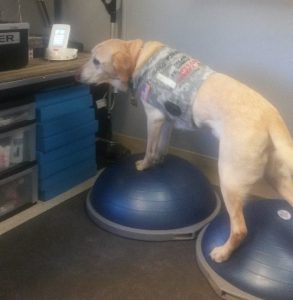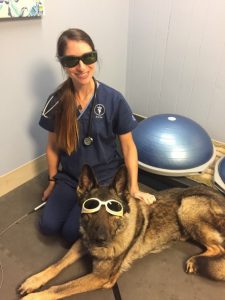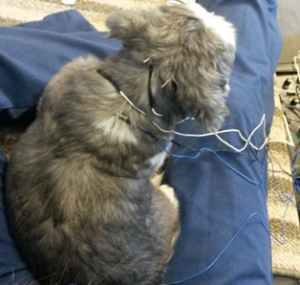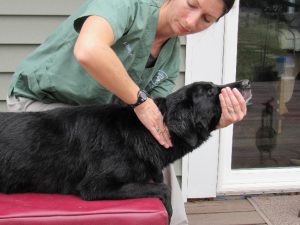Physical rehabilitation is the diagnosis and management of patients with painful or functionally limiting conditions, particularly those with injury or illness related to the neurologic and musculoskeletal systems. The goal of rehabilitation is to achieve the highest level of function, independence and quality of life possible for the patient.
Veterinarians certified in animal rehabilitation will work closely with your pet’s primary care and specialty veterinarians. They will also prescribe a treatment program including additional therapies that are specifically designed to meet your pet’s needs. This multimodal approach provides greater opportunity for a successful outcome. Possible rehabilitation therapies that may be recommended for your pet are listed below.
 Therapeutic Exercise
Therapeutic Exercise
Therapeutic exercises can improve strength, flexibility, balance and coordination and can slow progression of disease, leading to an enhancement in mobility and better quality of life. A rehabilitation practitioner professional will devise an individualized plan for your pet with specific goals.
Thermotherapy
Thermotherapy is the use of ice or heat to affect tissues. This therapy can be used in a rehab facility and taught to clients to perform at home. Use of cryo- or cold therapy can decrease inflammation and reduce pain. Heat can be applied to increase blood flow and aid in muscle relaxation.

Therapeutic Laser
Laser therapy is the use of light (typically infrared) energy to stimulate tissue repair and provide pain management. Laser therapy may alleviate muscle and joint discomfort, relieve symptoms of arthritis, relax muscle spasms and increase blood flow to an area, helping injuries to heal.
Therapeutic Ultrasound
Ultrasound is the use of sound waves to create heating (thermal effects) and vibration (non-thermal effects). Therapeutic ultrasound breaks down scar tissue, increases muscle elasticity, improves circulation and reduces pain. It is commonly used for muscle and tendon injuries, fractures and areas of restricted range of motion.
Therapeutic Massage
Massage therapy is a series of manual techniques used to improve a patient’s physical and emotional well-being. Physiological benefits of massage include pain relief, improved joint mobility, relaxation and increased circulation.
Manual Therapy / Joint Mobilization / Passive Range of Motion
Manual therapy can include a variety of techniques, including passive range of motion (PROM), joint mobilization and chiropractic. Manual therapies can be of great benefit to joints, allowing for greater movement and can also provide significant pain relief.
Land Treadmill
Treadmills are useful for encouraging use of an injured limb following surgery or injury, retraining gaiting after neurologic illness and for fitness training. They can also be used to warm up tissues prior to therapeutic exercise sessions.
Neuromuscular Electrical Stimulation (NMES)
NMES sends electrical impulses to nerves, causing muscles to contract. It can be used to prevent muscle atrophy, offsetting the effects of disuse that may occur after surgery or injury.
Transcutaneous Electrical Nerve Stimulation (TENS)
TENS decreases pain and inflammation by providing a low level electrical current which disrupts the normal pain perception pathways.

Acupuncture
Acupuncture is the insertion of fine needles into specific points on a patient to produce a physiologic response. Stimulation of these points can lead to an increase in circulation, decrease in muscle spasm and modulation of pain. Acupuncture can treat both musculoskeletal and neurologic issues and is often used in conjunction with other therapies.
 Veterinary Spinal Manipulative Therapy
Veterinary Spinal Manipulative Therapy
Veterinary spinal manipulative therapy or VSMT (same as chiropractic in people) is based on the relationship of the spinal column to the nervous system as well as the role of the spinal column in biomechanics and movement. Various manual therapy techniques are used during sessions to keep the musculoskeletal system functioning normally.
Pulsed Electromagnetic Field (PEMF) Therapy
PEMF therapy uses pulsing electromagnetic fields to speed healing, reduce inflammation and provide pain relief. PEMF therapy can be delivered via mats, jackets and even portable loops.
Orthotics, Prosthetics and Assistive Devices
A custom fitted splint, orthotic device, or cart may be recommended for your pet. These devices are used to support an injured limb while it heals, to correct a deformity or to encourage correct limb use. Carts are fitted to patients that are paralyzed or unable to walk without support.
Trigger Point Therapy
Trigger points are sensitive areas within muscle tissue that cause pain. They can form acutely in athletes as well as in patients with chronic orthopedic or neurologic issues. Trigger point therapy helps to release these constricted areas, thereby alleviating discomfort.
Information courtesy of www.rehabvets.org

 Like us on FaceBook
Like us on FaceBook